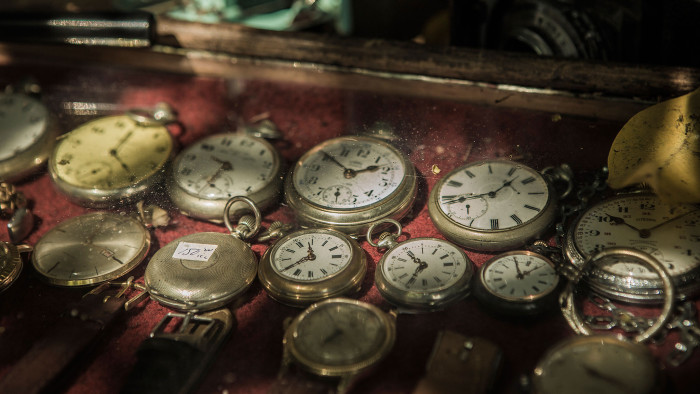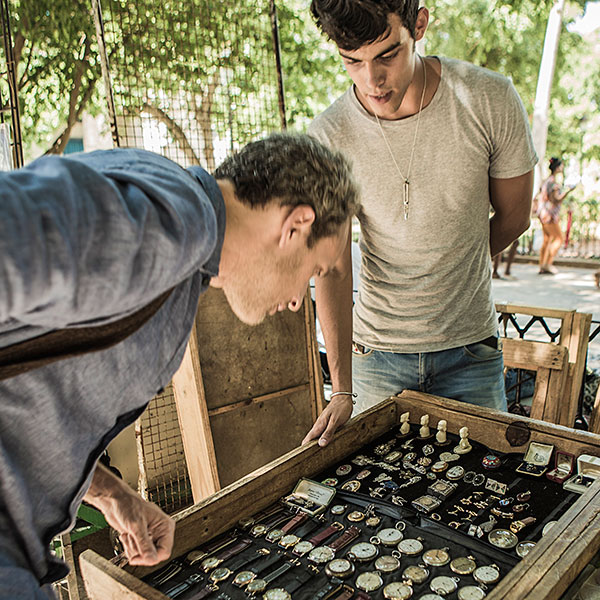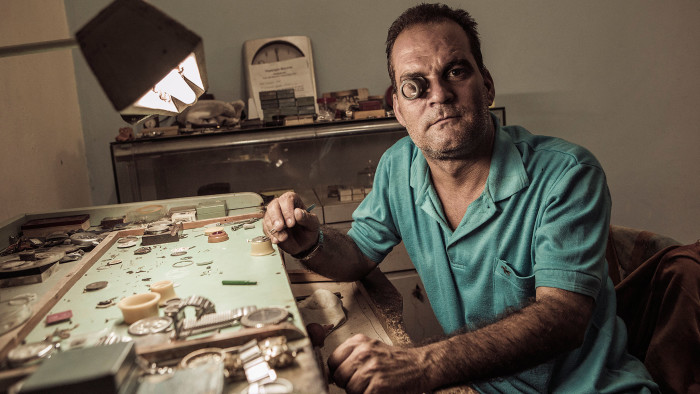Cuba, unlikely home to Rolex’s longest-standing repairman

Roula Khalaf, Editor of the FT, selects her favourite stories in this weekly newsletter.
It is a sultry Wednesday afternoon in Havana and in a town square on the corner of 21st and H Streets, a man smokes a cigar under a tree, a father throws a baseball to his son and two women chat on a park bench. It would be a bustling workday anywhere else but this is socialist Cuba where, as it is often said, time seems to stand still.
I am searching for the best watch repairman in Cuba. After a long hunt, I think I have found him. Waldo Fernández Longueira, or “Valdi” as he is known, has worked out of his Rolex-licensed premises in this neighbourhood for almost 60 years. Valdi, 77, a maestro relojero or master watch repairman, is Rolex’s longest-serving repairman, on duty since 1957. Whether out of Swiss discretion or Cuban circumspection, Rolex’s website makes no mention of him.
I have tracked down Valdi via an acquaintance of a friend of a relative. (This is how most information still circulates in a country where the digital superhighway remains more of a dusty byroad.) Through this grapevine, I hear of a Havana resident who helped out an English visitor with a fetish for Rolexes — and transvestites. The visitor had been robbed of his watches after he took a trans sex worker home and, figuring that the stolen Rolexes would eventually end up at Valdi’s, the Cuban and the Englishman sought him out to recover them. Via them I got Valdi’s address.
I walk up the front steps of an Art Deco apartment building. A discreet sign, no bigger than a postcard, is pinned to the door. It says, simply, “Rolex. 8.30am to 1pm. Monday to Friday. Ring APT 33.” I press the button, a buzzer sounds, the door clicks open and I walk in.
When I enter his apartment, a stout man with a loupe — the small magnifying glass used by watchmakers — on his forehead emerges from the back and stands behind an iron grille (I think of the watch thief) that divides the spotlessly tidy room. I explain to Valdi the pains I have taken to find him and the interview I hope to have. He shakes his head. “I am an employee of Rolex and an interview will not be possible,” he replies courteously. “Sorry.” I plead my case, but Valdi remains as impassive as a grandfather clock.
The existence of fine watches and excellent repairmen in Cuba may seem improbable. Why are there high-quality timepieces in this country anyway? The notion is the antithesis of socialist austerity. Then there is the irony of earning a living by repairing watches in a country frozen in time. Yet Cuba has a reputation for vintage timepieces in the same way that it has a reputation for antique cars, which are still motoring, somehow, after 60 years.
. . .
Before the revolution in 1959, when Fidel Castro and his bearded rebels seized control of the country from dictator Fulgencio Batista, fine watches were as much a part of Havana life as crisp linen suits, extravagant cocktails, superior cigars and fantailed Chevrolets. In the early 1900s, Cuervo y Sobrinos, a local jeweller, began importing European watches and stamping its marque on the frontispieces. Patek Philippe and Rolex opened their own Havana branches in the 1940s and 1950s, adding to the circulating stock.
“Havana before 1959 was like Monaco today, on steroids,” a resident European and watch aficionado tells me. “After the revolution, many of the watches from that era were left behind, sometimes hidden in walls. Now, with economic times so hard, they are coming out of the woodwork — literally. I recently bought a 1930s Rolex Aviator,” he says.
“My best source,” he notes darkly, “is an undertaker.”
Expensive marques pandered to a Cuban fondness for luxury that historians say grew out of sugar planters’ fortunes in the 19th century. As one visiting Bostonian businessman then noted of a particularly ostentatious plantation: “The luxuriousness of the residence is known throughout the island . . . It seems like a fairy tale . . . In the morning, gin flowed from a fountain in the garden, and in the afternoon there burbled a flow of Cologne, to the delight of the guests.”
The sugar industry is itself time-sensitive — for one, the sugar content of cane decays quickly after it is cut in the fields — and Cuba, in its day, was the world’s biggest producer and exporter. The sugar business’s strict schedules and awareness of fluctuating prices mean it is characterised by “extreme time consciousness”, anthropologist Sidney Mintz has said. Such habits have imprinted themselves on the Cuban psyche too. Founded in 1947, Radio Reloj, or Radio Clock, is still broadcasting today with its tick-tock background sound and once-a-minute announcement of the time.
. . .

Drawn to the start of Cuba’s watch story, I go to see the original Cuervo y Sobrinos shop on San Rafael Street. Long closed, it is now a second-hand clothes store called Praga, although the jewellers’ old safes are still visible at the back. Next door there is a watch shop, but its repairman says he only replaces batteries. Yet vintage Cuervo y Sobrinos watches can still be found in the flea market in Havana’s Plaza de Armas.
“They all work!” one stallholder enthuses. Priced at between $90 and $300, he says he sells a watch every three months or so. “Some tourists visit Havana just to buy them.”
“But are they real?” I ask, knowing that, like the classic cars that only run thanks to miraculous mechanical ingenuity, these watches’ delicate movements are unlikely to be originals. “Finding spare parts is hard,” he admits, making an abracadabra movement with his hands. “Mostly they come from retiring relojeros [watch repairmen], who sell their stock. Relojeros are a disappearing breed, you know.”
Cubans’ fondness for watches continued after the revolution. Che Guevara wore a Rolex; Fidel Castro wore two. Castro’s choice seems bizarre given his infamy for being so late and talking so long, but that was in the early days of the revolution and he, with shrewd symbolism, wore one watch set to Havana time and another to Moscow’s. Castro was also canny enough to set up a school, now shut, to train repairmen.
Manuel Ojea is one graduate. He lives in the working-class neighbourhood of La Víbora, near the offices of state security where, as locals say, even the mute learn how to talk. Mr Ojea, 44, apologises for being stripped down to his shorts when he welcomes me into his cramped bedsit. He has been fixing the plumbing, he says. Paint peels from his walls and bits of watches and clocks — straps, empty cases, broken faces, the detritus of timekeeping — lie in tidy piles all around.
Mr Ojea comes from a family of watch repairers. His grandparents, his father, his mother, his aunt and his uncle have all worked in the craft, he says, as do a cousin and a brother-in-law, although they now live in Spain.

“Relojeros make up a small world,” he says, settling down at a work bench cluttered with the tools of the trade: fine tweezers, tiny screwdrivers, an angle-poise strip light, small pots of lubricant and, of course, a loupe. He screws it into his right eye and begins reassembling a clunky Soviet timepiece.
“We all know each other, although there are very few good relojeros here nowadays. Most of them have died or emigrated. I am one of the few left,” he says. “I can fix anything: Patek, although you don’t see them here any more; Seiko; Soviet watches like this one, ugly but sturdy; Rolex; you name it. The problem is parts. You can’t get them.” Mr Ojea wipes the sweat off his brow with a dirty rag. “Still, I make a good-enough living, I suppose.”
Despite the passage of years, fine watches — Rolexes especially — remain a sign of government favour in Cuba, a gift dispensed to worthy revolutionaries, and thus a sign of power. Cuba’s “Rolex Revolution” may even have set the trend for fine watches among other revolutionaries, in the same way that Che’s image has become a kitsch icon.
Libya’s Muammer Gaddafi had a fondness for Rolex watches, ordering them with his signature stamped on their faces. So did Syria’s former president Hafez al-Assad. The son of Nicaraguan president Daniel Ortega, a Fidel Castro protégé, has a fondness for expensive watches. Yet it is in socialist Venezuela, Cuba’s closest ally, that revolutionary bling has reached its apogee.
There, despite desperate shortages of basic goods, senior government officials flaunt their status on their wrists. Many of these “chavista” followers of the late Hugo Chávez have since been featured in an opposition blog, “Relojes del Chavismo” or “Chavismo’s Watches”, which lists the expensive watches favoured by so-called revolutionary leaders. General Vladimir Padrino López, minister of defence, sports an IWC Pilots Anthracite Dial that sells for $12,700 — equivalent to four decades’ salary at Venezuela’s average wage, according to the website. Delcy Rodríguez, foreign minister, seems modest by comparison with a Cartier Ronde Solo ($2,800).
. . .
Such excess is a world away from Cuba, where time, rather than vulgar excess, is the fixation. For all its faded beauty, the island often seems like a waiting room. Fidel Castro, 90, has retired, and his brother and successor Raúl Castro, 85, has begun gradual economic reforms to Cuba’s Soviet-style economy under the rubric “without hurry but without pause”. Foreigners often say they want to visit the island “before it all changes”, especially given its budding rapprochement with the US. But for most Cubans, change cannot come soon enough. “We can wait all the time we want. But time will not wait for us,” says Juan Triana, a Cuban economist.
Meanwhile, although time may not move fast, Cuba’s people do. Its population is around 11m, but another 2m live abroad. Some of them are relojeros, seeking new lives outside Cuba.
Indeed, after I return to Miami a few weeks later, I stumble upon the workshop of Julian Pelea — again through a long chain of happenstance. A maestro relojero, with the documentation to prove it, Mr Pelea left Cuba in 1998. In the intervening years, he has set up a thriving business next to a 7-Eleven in a strip mall in Key Biscayne — a neighbourhood favoured by the Latin American well-off.
Today, Mr Pelea, 66, has a reputation for being able to fix anything. Testament to his skill are the framed photographs on his shop’s wall of satisfied clients, who include the actor Andy Garcia. “The oldest piece I have fixed was an 18th-century pocket watch from Liverpool with a rack level mechanism that was extraordinary,” he says. “I get clients from all over. They tell me I am the best repairman they know. I don’t know if that’s true. But that’s what they say.”
It is well acknowledged that you can now find in Miami what you cannot in Havana — be that car parts, revolutionary school uniforms or even master watch repairmen. Yet Mr Pelea sees his trade as a dying craft, with few maestros remaining. Valdi is an old friend who visits regularly. “In any country other than Cuba, he would have set up his own business,” Mr Pelea says. Others include Orestes Alfonso and Pablo Garcia, both in Miami, and Carmelo, a 90-year old relojero, also in Miami “and still going strong”.
A worried-looking woman comes into the shop with her husband’s Rolex, complaining that it no longer runs. Pelea asks what he does for a living. “He works at a computer,” she replies. “Ah! Say no more. He doesn’t move his arms enough.”
Mr Pelea tests the watch with a Vibrograf — “a watch stethoscope”, he calls it — and takes off the back to examine the movement inside. His work bench is littered with the same minute tools as was Mr Ojea’s in Havana, and its surface is painted the same shade of light green, to calm the eyes. “Don’t worry,” he says. “We can fix this, no problem.”
While his latest client waits, relieved, Mr Pelea mentions a training course that, he says, Rolex requires of its US network to ensure standards. “It’s expensive, but what can it possibly teach me?” he says. He has survived this long without the qualification. “And to think: I came to this country to be free!”
Comments